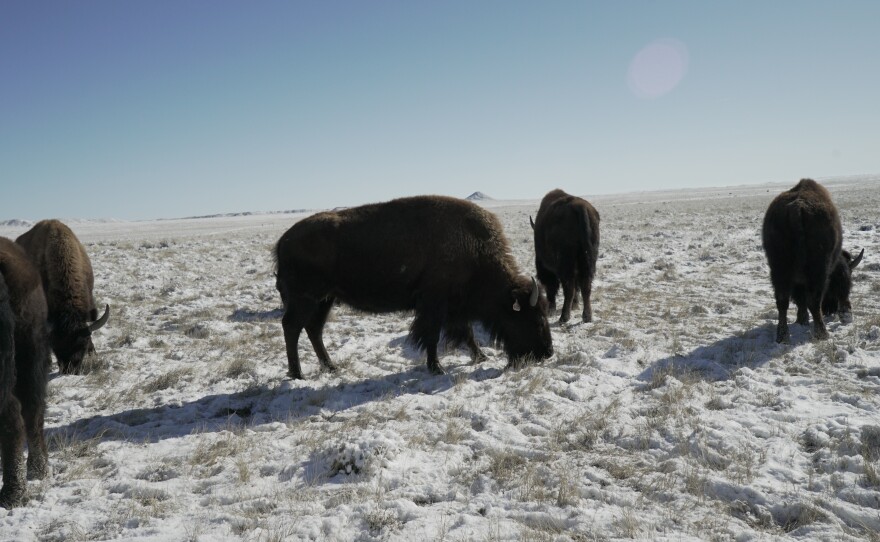On crisp, sunny morning in February, Jennifer Barfield threw large vegetable pellets from her car window. She was trying to lure a distant herd of bison closer.
It worked. The large brown animals – also known as buffalo – came right up to the car.
“Nothing like being chased by a herd of bison on Sunday morning,” Barfield joked.
Barfield wasn’t summoning the bison for fun. She was checking up on the Laramie Foothills Conservation Bison Herd, making sure they were healthy and had access to water. Since November 2015, the animals have lived in a fenced area at Soapstone Prairie Natural Area, managed by the City of Fort Collins Natural Areas, and Red Mountain Open Space, managed by Larimer County Natural Resources.
The 36 bison are the genetic offspring of the herd that lives in Yellowstone National Park. The Yellowstone herd and its DNA are coveted because they do not have the cow genes commonly carried by bison due to interbreeding. This makes the Laramie bison direct descendants of the animals that roamed the Great Plains for centuries.
But there is a problem.
Some of the Yellowstone bison carry a disease called brucellosis that can cause miscarriages in cattle and other livestock.
That is where Barfield comes in.
“It basically started with me playing in the lab a bit,” she said. “Just kind of on the side of what I was already working on.”
Barfield is an assistant professor in the College of Veterinary Medicine and Biomedical Sciences at Colorado State University. She specializes in animal reproduction and is the scientific lead for the bison conservation project.
In 2011, she rid bison sperm of brucellosis using a technique that was originally created to clean the semen of HIV positive men. Since then, the reproductive research has birthed calves from artificial insemination, in vitro fertilization and embryo transfer.
“The first year we tried the embryo transfers, we had a calf,” she said. “That was the calf that was born at the Bronx Zoo and now he’s breeding with females there.”
“I always use their courage as a philosophy.”
Centuries ago, tens of millions of buffalo roamed North America. The Great Sioux Nation was one of dozens of native nations that lived on the Great Plains – an area that spanned from what is now the Canadian border to Texas and Minnesota to Montana. The Lakota, Nakota and Dakota Nations, tribal divisions of the Great Sioux Nation, followed the buffalo around the northern plains and used the animal for everything, from food and clothing to shelter and ceremonial rituals.
Emil Her Many Horses is an associate curator at the Smithsonian’s National Museum of the American Indian and a member of the Oglala Lakota Nation. He said the buffalo was important in origin stories and ceremonial rituals.
“The Lakota people emerged from the earth and were taught how to use the buffalo to survive. We also have the bringer of the sacred pipe,” he said, detailing one such story. “She brought the sacred pipe and also taught the people seven ceremonies. And then, when she left, she turned into a white buffalo.”
But when the Europeans colonized America, tens of millions of buffaloes were slaughtered. For Native Americans, their way of life was changed forever.
“They knew that (the buffalo) was our resource of survival,” said Doug Good Feather, a member of the Hunkpapa Lakota Nation. “We had to adapt to reservation life.”
The buffalo may have been nearly eradicated, but their teachings were not. They were passed down through the generations and today, Native Americans like Good Feather still follow the ways of the animal.

“I always use their courage as a philosophy. Because when a winter storm or any kind of storm comes, they don’t turn around and run, they turn and face it,” he said. “They walk into it because when you walk into it, is the faster you’re going to come out of it.”
Good Feather, a veteran, is the executive director of the Lakota Way Healing Center and works with people dealing with trauma, addictions and homelessness. He uses Lakota traditions, language, songs and spirituality to counsel those who need help.
“Everything that I do is, in my life, to inspire and help and heal people and to find their center and their calling in life, is through the philosophy of the indigenous ways of life,” he said.
Good Feather lives in Mead, Colorado and has yet to see the Laramie herd.
But the opportunity is there. Soapstone and Red Mountain are open to the public.
Good Feather said the herd could revitalize old ceremonies involving the buffalo.
“Rights of passages are very important to people’s lives, especially to our youth to give them identity and confidence and so that’s part of the buffalo teachings as well,” he continued. “So, I think it would be very powerful and impactful on different cultures and sharing those cultures with society.”
“Hopefully I’ll breed myself out of a job.”
After leaving the disease-free Laramie herd, Barfield returned to her lab at CSU to continue her experiments and research.
Last year, the first calf was born through in vitro fertilization and will be integrated into the Laramie herd later in March.
While her reproductive research continues, Barfield has grown the herd to a size where they are now also breeding on their own.
"That’s really kind of my goal. To be able to step back and say, ‘OK, they’re healthy enough. The herd is big enough, we’re gonna let them do it on their own,’” she said. “So hopefully I’ll breed myself out of a job.”









